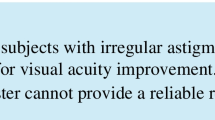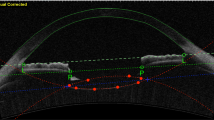Abstract
Purpose
To evaluate the accuracy of wavefront-derived objective refraction in pseudophakic eyes.
Methods
Retrospective case series. A total of 356 eyes (356 patients) that underwent phacoemulsification and posterior chamber intraocular lens implantation were included. Noncycloplegic subjective manifest refraction (MR) and objective refraction results from the wavefront aberrometer were obtained and compared. Subgroup analysis of objective refraction at 2.6-mm zone was performed based on axial length (AL) and average keratometry.
Results
The biases (at the 2.6-mm, 3-mm, and 4-mm zones) were − 0.29 ± 0.37 D, − 0.53 ± 0.41 D, and − 0.51 ± 0.60 D for sphere; − 0.27 ± 0.36 D, − 0.52 ± 0.38 D, and − 0.53 ± 0.51 D for spherical equivalent (SE); 0.03 ± 0.20 D, 0.03 ± 0.22 D, and 0.04 ± 0.27 D for J0; and 0.01 ± 0.16 D, 0.03 ± 0.22 D, and 0.01 ± 0.22 D for J45, respectively. Objective refraction for sphere, SE, and J0 (at 2.6 mm, 3 mm, and 4 mm) was significantly different from MR (P < 0.05), while J45 values were equal. The objective refraction at 2.6 mm was the most accurate in short eyes (≤ 22.5 mm) with a minimum bias for SE (− 0.15 ± 0.28 D) and highest percentage of SE within ± 0.25 to ± 0.75 D of MR. However, there was no difference between the keratometry subgroups.
Conclusions
The wavefront aberrometer achieved the best accuracy at 2.6 mm in pseudophakic eyes with short AL. It still needs modification to be used as a substitute for MR in such patients.



Similar content being viewed by others
Data availability
The data used to support the findings of this study are available from the corresponding author upon request.
References
McGinnigle S, Naroo SA, Eperjesi F (2014) Evaluation of the auto-refraction function of the Nidek OPD-Scan III. Clin Exp Optom 97:160–163. https://doi.org/10.1111/cxo.12109
Jinabhai A, O'Donnell C, Radhakrishnan H (2010) A comparison between subjective refraction and aberrometry-derived refraction in keratoconus patients and control subjects. Curr Eye Res 35:703–714. https://doi.org/10.3109/02713681003797921
Shober HA, Dehler H, Kassel R (1970) Accommodation during observations with optical instruments. J Opt Soc Am 60:103–107. https://doi.org/10.1364/JOSA.60.000103
Ghose S, Nayak BK, Singh JP (1986) Critical evaluation of the NR-1000F Auto Refractometer. Br J Ophthalmol 70:221–226. https://doi.org/10.1136/bjo.70.3.221
Tsuneyoshi Y, Negishi K, Tsubota K (2017) Importance of accommodation and eye dominance for measuring objective refractions. Am J Ophthalmol 177:69–76. https://doi.org/10.1016/j.ajo.2017.02.013
Nissman SA, Tractenberg RE, Saba CM, Douglas JC, Lustbader JM (2006) Accuracy, repeatability, and clinical application of spherocylindrical automated refraction using time-based wavefront aberrometry measurements. Ophthalmology 113(577):e571–e572. https://doi.org/10.1016/j.ophtha.2005.12.021
Wang L, Misra M, Pallikaris LG, Koch DD (2002) Comparison of a ray-tracing refractometer, autorefractor, and computerized videokeratography in measuring pseudophakic eyes. J Cataract Refr Surg 28:276–282. https://doi.org/10.1016/S0886-3350(01)01103-8
Melles RB, Holladay JT, Chang WJ (2018) Accuracy of intraocular lens calculation formulas. Ophthalmology 125:169–178. https://doi.org/10.1016/j.ophtha.2017.08.027
Thibos LN, Wheeler W, Horner D (1997) Power vectors: an application of Fourier analysis to the description and statistical analysis of refractive error. Optom Vis Sci 74:367–375. https://doi.org/10.1097/00006324-199706000-00019
Bland JM, Altman DG (1986) Statistical methods for assessing agreement between two methods of clinical measurement. Lancet 1:307–310. https://doi.org/10.1016/S0140-6736(86)90837-8
Shah S, Naroo S, Hosking S, Gherghel D, Mantry S, Bannerjee S, Pedwell K, Bains HS (2003) Nidek OPD-scan analysis of normal, keratoconic, and penetrating keratoplasty eyes. J Refract Surg 19:S255–S259. https://doi.org/10.3928/1081-597X-20030302-18
Perez-Straziota CE, Randleman JB, Stulting RD (2009) Objective and subjective preoperative refraction techniques for wavefront-optimized and wavefront-guided laser in situ keratomileusis. J Cataract Refract Surg 35:256–259. https://doi.org/10.1016/j.jcrs.2008.10.047
Gualdi L, Cappello V, Giordano C (2009) The use of NIDEK OPD Scan II wavefront aberrometry in toric intraocular lens implantation. J Refract Surg 25:S110–S115. https://doi.org/10.3928/1081597X-20090115-06
Zhu R, Long KL, Wu XM, Li QD (2016) Comparison of the VISX wavescan and OPD-scan III with the subjective refraction. Eur Rev Med Pharmacol Sci 20:2988–2992
Hamer CA, Buckhurst H, Purslow C, Shum GL, Habib NE, Buckhurst PJ (2016) Comparison of reliability and repeatability of corneal curvature assessment with six keratometers. Clin Exp Optom 99:583–589. https://doi.org/10.1111/cxo.12329
Asgari S, Hashemi H, Jafarzadehpur E, Mohamadi A, Rezvan F, Fotouhi A (2016) OPD-Scan III: a repeatability and inter-device agreement study of a multifunctional device in emmetropia, ametropia, and keratoconus. Int Ophthalmol 36:697–705. https://doi.org/10.1007/s10792-016-0189-4
Kinge B, Midelfart A, Jacobsen G (1996) Clinical evaluation of the Allergan Humphrey 500 autorefractor and the Nidek AR-1000 autorefractor. Br J Ophthalmol 80:35–39. https://doi.org/10.1136/bjo.80.1.35
Oyo-Szerenyi KD, Wienecke L, Businger U, Schipper I (1997) Autorefraction/autokeratometry and subjective refraction in untreated and photorefractive keratectomy-treated eyes. Arch Ophthalmol 115:157–164. https://doi.org/10.1001/archopht.1997.01100150159002
Bennett JR, Stalboerger GM, Hodge DO, Schornack MM (2015) Comparison of refractive assessment by wavefront aberrometry, autorefraction, and subjective refraction. J Optom 8:109–115. https://doi.org/10.1016/j.optom.2014.11.001
Toh T, Kearns LS, Scotter LW, Mackey DA (2005) Post-cycloplegia myopic shift in an older population. Ophthalmic Epidemiol 12:215–219. https://doi.org/10.1080/09286580590964784
Wang Y, Zhao KX, Jin Y, Niu YF, Zuo T (2003) Changes of higher order aberration with various pupil sizes in the myopic eye. J Refract Surg 19:S270–S274. https://doi.org/10.3928/1081-597X-20030302-21
Carkeet A, Velaedan S, Tan YK, Lee DY, Tan DT (2003) Higher order ocular aberrations after cycloplegic and non-cycloplegic pupil dilation. J Refract Surg 19:316–322. https://doi.org/10.3928/1081-597X-20030501-08
Code availability
Not applicable.
Funding
This study was financially supported by the grant from the National Key Research and Development Program of China (No. 2017YFC1104603).
Author information
Authors and Affiliations
Contributions
All authors contributed to the study conception and design. Material preparation, data collection and analysis were performed by Min Hou and Yujie Ding. The first draft of the manuscript was written by Min Hou and all authors commented on the previous versions of the manuscript. All authors read and approved the final manuscript.
Corresponding author
Ethics declarations
Conflict of interest
The authors declare that they have no conflict of interest.
Ethics approval
All procedures performed in studies involving human participants were in accordance with the ethical standards of the institutional committee and with the 1964 Helsinki Declaration and its later amendments or comparable ethical standards. This retrospective study was approved by the Institutional Review Board of Zhongshan Ophthalmic Center, Sun Yat-sen University (No. 2019KYPJ124).
Consent for publication
The participant has consented to the submission of case report to the journal.
Additional information
Publisher’s note
Springer Nature remains neutral with regard to jurisdictional claims in published maps and institutional affiliations.
Electronic supplementary material
ESM 1
(PDF 188 kb)
Rights and permissions
About this article
Cite this article
Hou, M., Ding, Y., Liu, L. et al. Accuracy evaluation of objective refraction using the wavefront aberrometer in pseudophakic eyes. Graefes Arch Clin Exp Ophthalmol 258, 2213–2221 (2020). https://doi.org/10.1007/s00417-020-04806-5
Received:
Revised:
Accepted:
Published:
Issue Date:
DOI: https://doi.org/10.1007/s00417-020-04806-5




